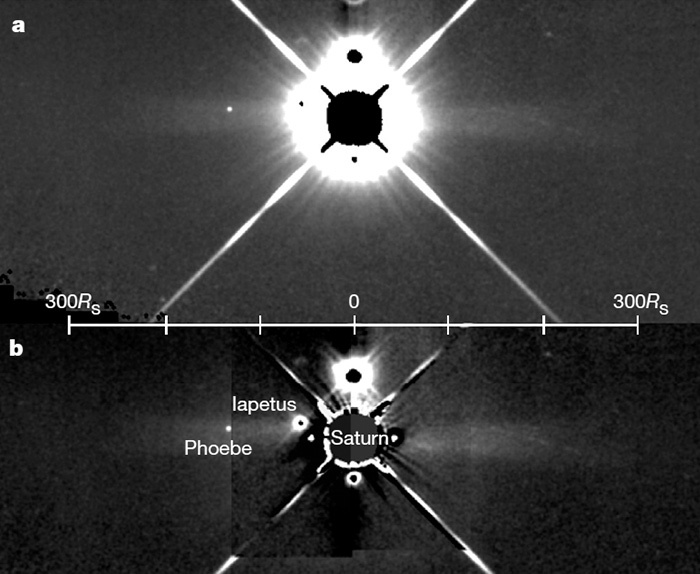Astronomers have studied the most distant ring of Saturn

In 2009, astronomers discovered: in addition to 25 nearby rings, Saturn has another subtle ring, located far beyond the rest. He was named the ring Phoebe (Phoebe ring), after the name of the satellite Phoebe. Presumably, the ring consists of particles of this satellite.
The illustration schematically shows the giant size of Phoebe’s ring compared to the planet itself (several points in the center).
')
This ring is quite deservedly included in the list of the strangest objects of the Universe discovered to date.
A dust band rotates around a gas giant at a distance of about 13 million km, which is almost 50 times further than other rings.
Phoebe's ring was discovered in 2009 with the help of the Spitzer Space Observatory, which observes space in the infrared and is capable of detecting particles about 10 microns in size. Particularly of such particles, the Phoebe's dust hoop is partially composed (the density per cubic meter was initially estimated at 10-20 particles).

Satellite Phoebe, photo from the apparatus "Cassini"
Unfortunately, on May 15, 2009, the Spitzer telescope ran out of refrigerant, so that he could not continue his observations.
In order to continue studying the ring, in June 2010, astronomers directed the lens of another Wide-field Infrared Survey Explorer (WISE) infrared telescope toward Saturn, which is in near-Earth orbit. And with its help, for the first time, it was possible to get the image of Phoebe’s ring entirely. In the photo it is visible as a rarefied dust cloud in the horizontal plane.
X


June 10, 2015 in the journal Nature published a study performed by a group of scientists from the University of Maryland, the University of Virginia and the Center for processing and analysis of infrared images at the California Institute of Technology. The study analyzed data from the WISE telescope.
The size of the ring and its distance from Saturn were greater than expected. In 2009, the particles were fixed at a distance of 128 to 207 Saturn radii (R S = 60,330 km) from the planet. The total vertical length of the ring is 40 R S. Thus, Phoebe’s ring is more than ten times larger than the ring E previously considered the largest.
The full radial extent was not possible to measure in the pictures from the Spitzer, as well as the characteristics of dust particles.
Pictures from WISE show that Phoebe’s ring is even bigger than expected: it extends from 100 R S to 270 R S (from 6 million km to 16 million km from the planet)! That is, 30% more than previously thought.
Scientists have compiled a model of the orbital dynamics of particles that took off from Phoebe as a result of a collision with extraneous space bodies, and have constructed theoretical power-law particle size distribution profiles. According to them, up to 10% of the cross-sectional area of the ring is made up of large particles with a radius of more than 10 cm, whose orbits could not descend into the ring for more than 4.5 billion years.
Thus, the ring of Phoebe is much older than the inner rings of Saturn. It was probably formed simultaneously with the solar system.
Unfortunately, the WISE telescope also ran out of coolant in 2010, and since then we have not received any new information about Phoebe's ring. According to scientists, now in space there is not a single device that could help in the study of this object.
Source: https://habr.com/ru/post/367365/
All Articles